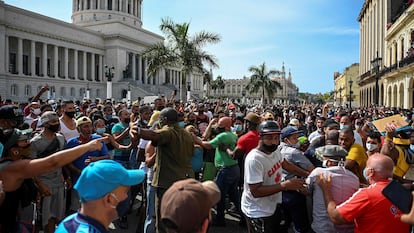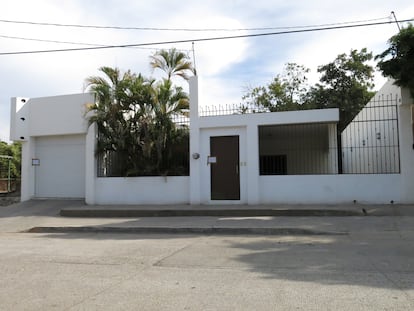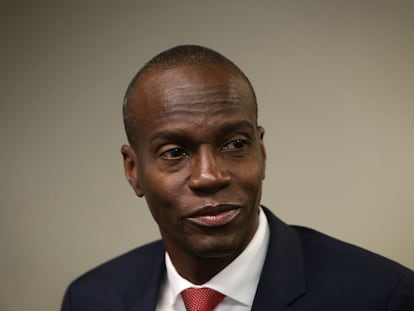Cuba sees one of the biggest protests against the government since the crisis of the 1990s
Thousands of people all over the country came out to demonstrate on Sunday, amid a situation of shortages and hardships that has been exacerbated by the pandemic. More than a hundred arrests were made
The streets of Havana and a number of other cities and towns in Cuba bore witness on Sunday to one of the biggest demonstrations against the island’s government since 1994, during the so-called “Special Period,” when hundreds of Cubans came out to protest against the precarious economic situation, just before the Cuban rafter crisis.
The causes behind the protests on Sunday, which saw thousands of people participate across the country and also led to hundreds of arrests, were the shortages and hardships being experienced by inhabitants of the island, which have been made worse by the effects of the coronavirus pandemic.
Unusual cries of “freedom” and “down with the dictatorship” could be heard throughout Old Havana and other areas of Cuba, amplified by social media.
The Cuban president, Miguel Díaz-Canel, immediately made an appearance on television blaming the United States for encouraging the protests and for its sanctions on Cuba for worsening the economic situation. “We are calling together all revolutionaries, all the communists, to come out onto the streets and go to the places where these provocations are taking place,” he said in reference to the protests.
The spark for the demonstrations came on Sunday in the small town of San Antonio de los Baños, near Havana, where hundreds of people came out onto the street to protest against long power outages and to demand that the authorities vaccinate them against Covid-19. Shortly afterward, however, their demands were transformed into cries of “freedom” and demands for political change.
Before long, the protests reached Facebook and were being broadcast live, prompting calls for more demonstrations online. Díaz-Canel traveled to San Antonio de los Baños at midday and toured the neighborhood, speaking about the difficult epidemiological situation that the country was facing and of the efforts the government was making to deal with it.
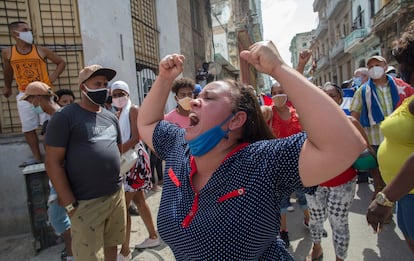
In recent days, the number of positive Covid-19 cases has multiplied exponentially in Cuba, as have the victims from the pandemic. The situation has placed provinces such as Matanzas on the brink of seeing their healthcare systems overwhelmed.
The Cuban president warned that while there may be “people with legitimate dissatisfactions due to the situation in which they are living, and also confused revolutionaries,” at the same time “there are opportunists, counterrevolutionaries and mercenaries paid by the US government to assemble this kind of demonstration.”
That was when the president said that he would “not allow provocations” and used the famous phrase that was a mantra of former Cuban president Fidel Castro: “The streets belong to the revolutionaries.” “No worm nor counterrevolutionary is going to take the streets,” he said, and called for a halt to “media campaigns” and for the “people not to allow themselves to be provoked.” That’s to say, he was calling on the faithful to combat the protests.
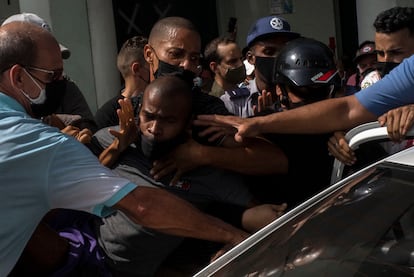
Soon news emerged via the internet of simultaneous protests in the eastern city of Palma Soriano, in Santiago de Cuba, in Alquízar and in other places, something that is unheard of in Cuba. There was also a protest outside the Cuban Institute of Radio and Television (ICRT), in the neighborhood of Vedado in Havana. The sit-in demonstration, which saw dozens of people take part, prompted a counter-protest that ended with an act of condemnation and the arrest of all those who were protesting.
At the same time, several thousand people gathered in Fraternidad Park, in Old Havana. The demonstrators had seen the other protests on social media. Very soon, there were several thousand people there – demonstrators, the curious and groups who defend the revolution. Some shouted, “Freedom!” and “Homeland and life!,” the latter – patria y vida – in reference to a song by a group of Cuban artists based in Miami and the island who have challenged the government in Havana. Others cried “Long live the revolution!” and “Homeland and Fidel!”
More than a hundred people were arrested by the police, all from the group that was calling for more freedom. Police vehicles were battered by protestors when people were taken away, while a Spanish photographer from the Associated Press (AP) agency was assaulted by officers in the midst of the protests. In Cárdenas, one of the worst-affected areas by the current coronavirus outbreak, a police patrol car was actually overturned. In the background to the unrest is the unhappiness among Cuban citizens caused by the crisis the country is facing, with hours of lines to purchase basic items and a serious situation of scarcity in terms of medications.

After having visited the streets of San Antonio de los Baños, Díaz-Canel appeared on Cuban television to speak about what was happening. It was then that he claimed that the guiding thread of the events, beyond the difficulties caused by the Cuban economy, was the worsening of the US embargo.
“They started to intensify a series of restrictive measures, an intensification of the blockade, of financial persecution against the energy sector with the objective of asphyxiating our economy, and for that to cause the yearned-for mass social uprising that sows the possibilities for, with all of the ideological campaigning that has been done, being able to call for the humanitarian intervention that would end in military interventions and meddling,” he claimed.
He mentioned the very difficult situation being faced in the province of Matanzas, with a coronavirus infection rate of more than 1,300 people per 100,000 inhabitants over the last 15 days. The crisis has prompted emergency measures to be taken, such as the government sending members of the Henry Reeve medical brigades, whom Cuba usually send to international missions when there are humanitarian catastrophes. Never before had they been deployed domestically.
“In a very cowardly, subtle and opportunistic and perverse way, based on the most complicated situations that we have had in provinces such as Matanzas and Ciego de Ávila, those who have always been taking advantage of the blockade and who serve as mercenaries on the street of the Yankee blockade, are starting to appear with doctrines of humanitarian aid and humanitarian corridors,” Díaz-Canel said during his address.
In a reflection of the official concern that was prompted by the protests on Sunday, after Díaz-Canel’s speech Cuban television broadcast a live program during which there were connections from all of the provinces of the country showing statements in support of the revolution and explaining that everything that was happening was due to the subversion being fostered by the United States, and amplified by social media. Come nightfall, a major police presence was deployed in the hottest streets of Havana. Just in case.
English version by Simon Hunter.
Tu suscripción se está usando en otro dispositivo
¿Quieres añadir otro usuario a tu suscripción?
Si continúas leyendo en este dispositivo, no se podrá leer en el otro.
FlechaTu suscripción se está usando en otro dispositivo y solo puedes acceder a EL PAÍS desde un dispositivo a la vez.
Si quieres compartir tu cuenta, cambia tu suscripción a la modalidad Premium, así podrás añadir otro usuario. Cada uno accederá con su propia cuenta de email, lo que os permitirá personalizar vuestra experiencia en EL PAÍS.
¿Tienes una suscripción de empresa? Accede aquí para contratar más cuentas.
En el caso de no saber quién está usando tu cuenta, te recomendamos cambiar tu contraseña aquí.
Si decides continuar compartiendo tu cuenta, este mensaje se mostrará en tu dispositivo y en el de la otra persona que está usando tu cuenta de forma indefinida, afectando a tu experiencia de lectura. Puedes consultar aquí los términos y condiciones de la suscripción digital.
More information
Archived In
Últimas noticias
Most viewed
- David King, chemist: ‘There are scientists studying how to cool the planet; nobody should stop these experiments from happening’
- Reinhard Genzel, Nobel laureate in physics: ‘One-minute videos will never give you the truth’
- Mexico completes its trade shift with the entry into force of tariffs on China and countries without trade agreements
- Oona Chaplin: ‘I told James Cameron that I was living in a treehouse and starting a permaculture project with a friend’
- Sinaloa Cartel war is taking its toll on Los Chapitos
